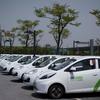能源与电网
2019
Apr
11
2019
Feb
20
. 2019. “Modeling formulation and validation for accelerated simulation and flexibility assessment on large scale power systems under higher renewable penetrations.” Applied Energy, 237, Pp. 145-154. Publisher's VersionAbstract
2019
Mar
07
2018年秋季学期新闻通讯
电力行业改革是否是中国绿色未来的必由之路?
. 2018. “The Impact of Power Generation Emissions on Ambient PM2.5 Pollution and Human Health in China and India.” Environment International, 121, Part 1, Pp. 250-259. Publisher's VersionAbstract
. 2018. “Hybrid life-cycle assessment for energy consumption and greenhouse gas emissions of a typical biomass gasification power plant in China.” Journal of Cleaner Production, 205, Pp. 661-671. Publisher's VersionAbstract
. 2018. “Power system capacity expansion under higher penetration of renewables considering flexibility constraints and low carbon policies.” IEEE Transactions on Power Systems, 33, 6, Pp. 6240-6253. Publisher's VersionAbstract
《金融时报》报道中国项目关于电动汽车充电方式对中国环境影响的最新研究
. 2018. “Changing carbon content of Chinese coal and implications for emissions of CO2.” Journal of Cleaner Production, 194, Pp. 150-157. Publisher's VersionAbstract







